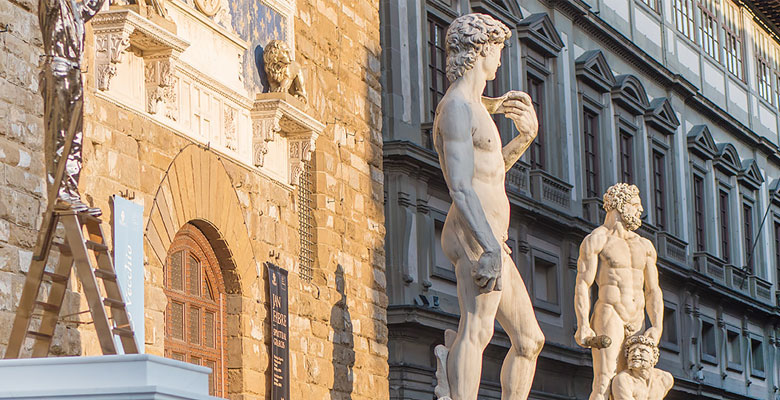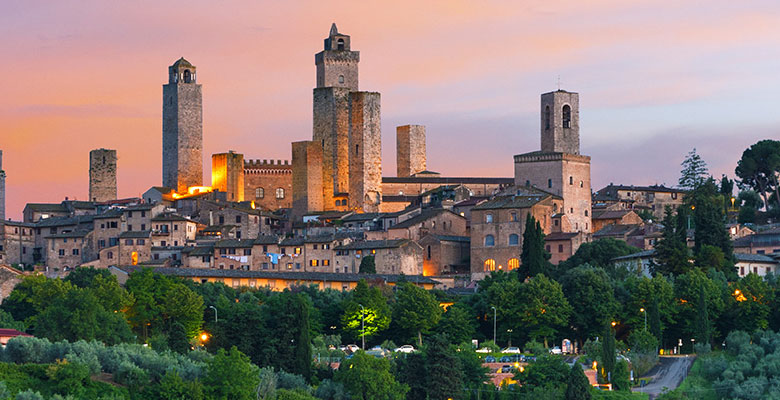Chianti: the heart of Tuscany's Golden Triangle
- By Jonathan Magoni
- 03 Nov 2018
- Where to go
With the crown jewels of the region – Florence, Siena and San Gimignano – glittering temptingly at each vertex, the so-called Golden Triangle is perhaps the most evocative area of Tuscany, conjuring images of astonishing artistic achievement, ravishing landscapes and some of the world’s favourite wines.

"Depending on your interests (and stamina), you can choose complete cultural immersion and cover all of Chianti in one trip, or take a more selective approach and confine yourself to one or two cities and a more leisurely pace. To help you decide, we’ve asked our Italy Product Director Jonathan Magoni to select both the must-see highlights and some interesting alternatives in each place.

Florence
Home to Michelangelo’s David, Brunelleschi’s dome and the extraordinary legacy of the Medici family, Florence is, some argue, the birthplace of modern civilization. It’s also a city on a very human scale, with green spaces, the iconic Arno and plenty of places to eat superbly well.
Must-see: There’s so much to see in Florence that you’ll be relieved to know that pretty much everything is within walking distance of the historic centre. Number one is Il Duomo, atop which sits Brunelleschi’s magnificent dome, still the biggest in the world over 600 years after it was built. You’ll need to pay (and usually queue) to access the dome via 463 steps, but the experience is memorable. From here you can stroll to the Piazza della Signoria, the beating heart of Florence since the Middle Ages, in under ten minutes, and then continue towards the river and the unmistakable Ponte Vecchio. Rammed with souvenir and jewellery shops, this remains a quintessential Florence landmark, though probably best viewed from outside in our opinion! Resist the urge to cross the Arno and head left instead, just a few minutes to our third classic: the Uffizi Gallery. The experience of so many world-famous images in real life and in one place is overwhelming but unmissable: pre-booking is a must.
An alternative take: For a different look at Florence, consider the creepily fascinating anatomical wax models at La Specola, one of the first science museums to open to the public in 1775 (not for the squeamish). The Oltrarno district lies on the quieter side of the Arno, a largely locals-only neighbourhood with lots of tiny craft workshops. Also on this side of the river you can find a seat in the shade at the Bardini Gardens, smaller than the neighbouring Boboli Gardens, but generally more peaceful. For a casual meal or picnic ingredients, hop back over the Arno and head for the always-busy Mercato Centrale, piled high with top quality local produce to eat in or take away and buzzing with just as many locals as visitors.

Siena
Small in size, but rich in every sense, Siena is a worthy rival for Florence in terms of its artistic and architectural heritage, but is most famous for the thrilling pageantry of Il Palio, a high-speed, bare-back horse race run around the city’s Piazza del Campo twice each summer.
Must-see: If you can get tickets for the Palio (2 July and 16 August every year) then you’ll be witnessing one of the greatest spectacles in Europe, even if it does only last less than 90 seconds! The atmosphere is electric, with an estimated two-thirds of the city’s population crowding in to watch, and there are non-ticket areas too if you are prepared to pack in with the locals.
Outside of Palio season, the uniquely shell-shaped Piazza del Campo is still the best place to begin a visit here. The piazza is dominated by the Torre del Mangia, which rises 102 metres above the city rooftops. The height is no accident: Siena’s city planners wanted to give both church and state equal status, so the Torre del Mangia was built to appear the same height as the magnificent bell tower on Siena’s Santa Maria Assunta cathedral. The views are breathtaking, absolutely worth the 400 steps you’ll have to climb to get there. From this height, the cathedral looks black and white, though in fact the ‘black’ is actually very dark green in homage to the traditional colours of the city. The inside is even more imposing, with works by Donatello and Michelangelo amongst the distinctive green and white marble columns.
An alternative take: Like any Italian town, Siena has ice-cream parlours on every other street corner, but for the connoisseur, there are a couple of special places worth seeking out. First is La Vecchia Latteria, a five-minute walk from the Piazza del Campo and so unprepossessing from the outside you might just walk past. All the ice cream is made daily on site, and you can see the machines churning away next to the counter. In the northern part of the city, close to the university, you’ll find student favourite the Kopakabana, which offers a staggering 200 flavours and more pocket-friendly prices compared to the city centre gelateria.
By way of a contrast to the crowded Torre del Mangia, just a five-minute walk away you’ll find a quiet oasis at a tiny urban farm, complete with donkeys, geese and chickens. Orto de’ Pecci used to supply fresh produce to the nearby hospital, but is now run as a social enterprise, with a small pizzeria open at lunchtimes and evenings.

San Gimignano
Blessed with probably the most distinctive skyline in Tuscany, this enchanting hilltop town is dominated by 16 towers, built in the 13th century as symbols of local power and wealth. San Gimignano prospered in the Middle Ages as an important stop on the Via Francigena pilgrimage route and has been a World Heritage Site since 1990.
Must-see: There were originally 72 towers in San Gimignano and, of the 16 that remain, the best one to climb is the Torre Grossa, with its classic Tuscan views over terracotta rooftops to the green and gold landscape beyond. Next, you should take time to discover the Duomo; the frescos here will send a shiver up your spine when you learn that their beautiful bright colours are entirely original, neither retouched nor restored since they were first painted 700 years ago. If you’re inspired by this artistry then we think you’ll love San Gimignano 1300, a remarkable museum and craft workshop with a very large ceramic replica of what the city looked like at its height in 1300. The detail is exquisite and the accompanying multi-media displays really do bring life to the medieval buildings and context to the history, inspiring and accessible for all age groups.
An alternative take: The Chianti area is of course best known for its red wines, but here in San Gimignano we encourage you to try the local Vernaccia wine. It’s a crisp, dry white and the perfect match for another local speciality: saffron risotto. Saffron has been grown here for over 700 years, and was famously used to pay off a city debt in lieu of cash after the 13th-century siege of Castello della Nera. You can visit the Museo del Vino in the town, or enjoy a tasting in one of the many wine shops.
A glass of Vernaccia might be just the thing to steady the nerves before you visit the Torture Museum, a gruesome collection that seeks to educate rather than titivate. The entry fee also covers the equally disturbing Museum of the Death Penalty a few doors away. Stomach-churning yet fascinating.
Finally, one of the best routes to a more tranquil San Gimignano experience is to get out and walk in the surrounding countryside, where every view recalls a famous painting or a scene from a movie. You can follow a circular tour on ‘white roads’ past vineyards along the Vernaccia Wine Route (around ten miles), with the towers of San Gimignano always on the horizon to guide you. Alternatively, follow the much shorter marked path around the outer city walls; their massive 13th-century bulk feels riddled with secrets and stories on one side, whilst on the other lies the pastoral perfection of the Chianti countryside laid out at your feet.
View all... Tuscany villas Tuscany hotels Tuscany








